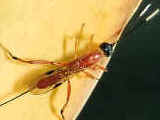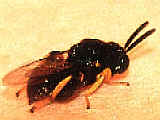|
|
Parasite Wasps - Superfamily ICHNEUMONOIDEA, CHALCIDOIDEA and CHRYSIDIDEA
This page contains pictures and information about Parasite Wasps that we found in the Brisbane area, Queensland, Australia.

Parasitic Wasps are the largest group in Hymenoptera. Because of their parasitic habit, most of them are still unknown.
Their larvae are either parasitic or predators. Most caterpillar are targeted host. Some species attacked other insects and spiders. The female wasp usually locates the food plants of the host then searches with her antennae for a suitable host. The female usually has the long ovipositor which is used to insert eggs into the host body. Some species lay eggs externally and attack the host from outside. The host will usually survive when the larvae is still living. Until the larvae fully grown, the larvae either pupates inside the dead host or form a cocoon outside.
Parasitic Wasps mainly belong to Family ICHNEUMONIDAE and Family BRACONIDAE. Members in this two families are very similar, the major different is their wings vein which has to be check under microscope for the small species. They have long and thin body, with narrow waist like wasps. Adults are active in day time and feed on flowers. Some species are colourful.
Superfamily ICHNEUMONOIDEA
 Family ICHNEUMONIDAE
Family ICHNEUMONIDAE- Members in this family have long and thin body, with narrow waist. Adults are active in day time and feed on flowers. Some species are colourful. The female usually has the long ovipositor which is used to insert eggs into the host body. Some species lay eggs externally and attack the host from outside. The host will usually survive when the larvae is still living. Until the larvae fully grown, the larvae either pupates inside the dead host or form a cocoon outside.
 Family BRACONIDAE
Family BRACONIDAE- Members in this family are usually small in size. Their larvae are parasitic. The host will usually survive when the larvae is still living. Until the larvae fully grown, the larvae either pupates inside the dead host or form a cocoon outside. Many aphid parasites are braconid and their life cycles are similar.
Superfamily CHALCIDOIDEA
 Family CHALCIDIDAE
Family CHALCIDIDAE- All members in chalcididae are parasitic. Most attack pupae of moths, butterflies and Diptera. Some parasitise other wasps or beetles. We found a moth pupa and brought it home to see what kind of moth it would be. However we end up saw a small wasp came out from the Pupa.
 Family
TORYMIDAE
Family
TORYMIDAE- We found one species in this family, which parasitised on mantid oothecae. Its head and thorax were metallic blue in colour, with abdomen from pale brown to dark brown in colour. Its hind legs upper part, or femur, were enlarged and dentate.
 Family
MYMARIDAE
Family
MYMARIDAE- They are the Insect Eggs Parasite Wasps that we cannot identify. We think they are in the family Mymaridae but not exactly sure. They are black in colour with body length 2-3mm long.
Superfamily CHRYSIDIDEA
 Family
CHRYSIDIDAE
Family
CHRYSIDIDAE- There are many Cuckoo Wasp species and they look similar. Usually they are metallic blue or green in colour. Most species are external parasites of other wasp larvae. Females lay eggs in nest of other wasps while the nest host collect food for larvae. Cuckoo Wasp larvae hatch and feed on the food or the host larvae.
- Reference and Link:
- 1. Insects of Australia, CSIRO, Division of Entomology, Melbourne University Press, 2nd Edition 1991, pp 930.
